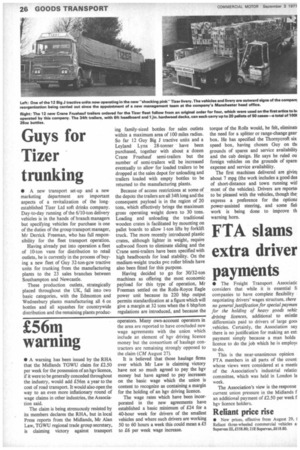Guys for Tizer trunking
Page 28

If you've noticed an error in this article please click here to report it so we can fix it.
• A new transport set-up and a new marketing department are important aspects of a revitalization of the longestablished Tizer Ltd soft drinks company. Day-to-day running of the 6/10-ton delivery vehicles is in the hands of branch managers but specifying vehicles for purchase is one of the duties of the group transport manager, Mr Derrick Freeman, who has full responsibility for the fleet transport operation.
Having already put into operation a fleet of 10-ton vans for distribution to retail outlets, he is currently in the process of buying a new fleet of Guy 32-ton-gcw tractive units for trunking from the manufacturing plants to the 23 sales branches between Southampton and Newcastle.
These production outlets, strategically placed throughout the UK, fall into two basic categories, with the Edmonton and Wednesbury plants manufacturing all 6 oz bottles and all squashes for countrywide distribution and the remaining plants produc ing family-sized bottles for sales outlets within a maximum area of 100 miles radius. So far 12 Guy Big J tractive units and a Leyland Lynx 28-tonner have been purchased, together with about a dozen Crane Fruehauf semi-trailers but the number of semi-trailers will be increased eventually to allow for loaded trailers to be dropped at the sales depot for unloading and trailers loaded with empty bottles to be returned to the manufacturing plants.
Because of access restrictions at some of the depots the trailers are all 34ft long and the consequent payload is in the region of 20 tons, which effectively brings the maximum gross operating weight down to 30 tons. Loading and unloading the traditional wooden crates is facilitated by mounting on pallet boards to allow 1-ton lifts by forklift truck. The more recently introduced plastic crates, although lighter in weight, require softwood floors to eliminate sliding and the Crane semi-trailers have been specified with high headboards for load stability. On the medium-weight trucks pvc roller blinds have also been fitted for this purpose.
Having decided to go for 30/32-ton machines as offering the most economic payload for this type of operation, Mr Freeman settled on the Rolls-Royce Eagle power unit because its 220 bhp output permits standardization at a figure which will give a margin at 32 tons when the 6 bhp/ton regulations are introduced, and because the torque of the Rolls would, he felt, eliminatt the need for a splitter or range-change gear box. He has specified the Thornycroft six speed box, having chosen Guy on th( grounds of spares and service availability and the cab design. He says he ruled ou foreign vehicles on the grounds of spare expense and service availability.
The first machines delivered are givim about 7 mpg (the work includes a good dea of short-distance and town running witl most of the vehicles). Drivers are reportel to be pleased with the vehicles, though the: express a preference for the optione power-assisted steering, and some fiet work is being done to improve th warning horn.










































































































































